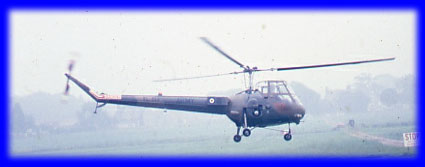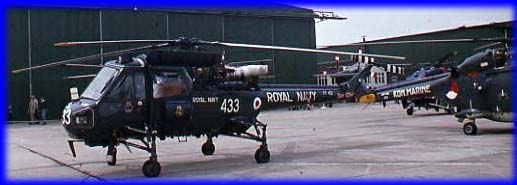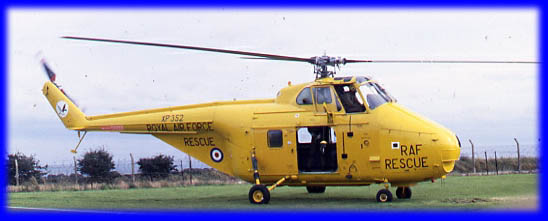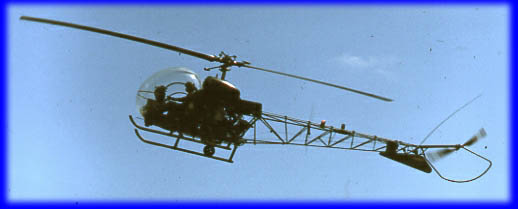 |
The Saunders-Roe Skeeter was originally
designed by the company founded by Autogyro pioneer Juan de la
Cierva. It was built by Saunders-Roe before that company was
absorbed by Westland. 88 were built, many being operated by the
British army from 1959 to 1967. They were said to be awful to fly.
This is the last flying example, seen at Old
Warden in July 1978. |
 |
The Westland Scout was loosely based on the
Skeeter but without so many vices. Its Nimbus turboprop engine made
it much smoother and gave it a top speed of 140mph. It could carry 5
passengers. It was the standard lightly armed small transport
helicopter for he British army until succeeded by the Lynx (below).
This Scout was at Bassingbourn in May 1978. |
 |
The Westland Wasp was essentially similar to
the Scout but was optimised for use by the Royal Navy on board their
frigates as an anti-submarine platform. Note the wheels instead of
the skid for landing. This Wasp was at
Yeovilton in August 1980. |
 |
The Westland Dragonfly is a license-built
version of the American Sikorsky S-51. It first flew in June 1949.
174 were built, primarily for the Royal Navy. It is powered by a
550hp Alvis Leonides nine cylinder radial engine. It was generally
used for light transport and rescue duties, in which capacity it can
seat four. Rotor diameter is 48 feet, and gross weight is 5,900lb.
It could fly at 95mph for a range of 300 miles. It was superseded in
service by the much more capable Whirlwind, below. US designations
were H-5 for the Air Force and HO2S / HO3S for the Navy.
This one was pictured in August 1974, with
David's father in the foreground. Location wasn't recorded but looks
very like Old Warden. |
 |
The Westland Whirlwind is a British
turboprop-powered derivative of the American Sikorsky S-55 (known in
the US Air Force as the H-19 Chickasaw and the US Navy as the HO4S
or the HRS). It is a tough and practical aircraft built in the 1950s
and early 1960s. The HAR10, illustrated, is mainly used for air sea
rescue and is powered by a Gnome turboshaft engine. It can carry
2,500lb or 10 people. This one was at
Boulmer in September 1978. |
 |
The Westland Wessex is yet another British
development of an American design, this time the Sikorky S-58 (HSS
or HUS to the US Navy, H-34 to the USAF). It is a much bigger
machine than the Whirlwind, being able to take up to 16 people plus
crew, but is primarily used as an anti-submarine aircraft.
This one was at Farnborough, date uncertain. |
 |
The Westland Sioux is a British version of
the American Bell 47 (H-13, HTL or HUL). It is a light two seat
helicopter for training and general duties. Its bubble canopy is
very distinctive and gives brilliant visibility. It is powered by a
single piston engine. This one was at
Millfield in June 1976. |
 |
The Westland Sea King is a license-built
version of the American Sikorsky S-61 (SH-3, HR3S, HSS2 to the US
Navy). It is capable of floating for some time if it ditches. It can
carry up to 26 people plus crew or be used for anti-submarine
warfare or (like the one illustrated) for rescue. Cruising speed is
135mph and range is 625 miles. It has been built in vast numbers.
This one was at Coltishall in May 1987. |
 |
The Westland Lynx was the only one of the
three Franco-British helicopters of the 1960s and 1970s to be
produced under British design leadership. It flew in 1971, and has
since replaced the Scout in Army service and the Wasp with the navy.
It has won numerous export contracts. Its two Rolls-Royce Gem
turboshaft engines are distinctive.
This one was at Fairford in July 2005. |
 |
The Westland Lynx 3 was a private venture
development of the Lynx, using advanced new rotor blades. Only one
was built. It first flew in June 1984. Its two Rolls-Royce Gem
turboshaft engines are uprated to 1,115shp. Gross weight increased
by 2,500lb to 13,000lb, and cruising speed increased from 140 to
150mph. No orders materialised.
Middle Wallop, July 1984, only just after its first flight. |